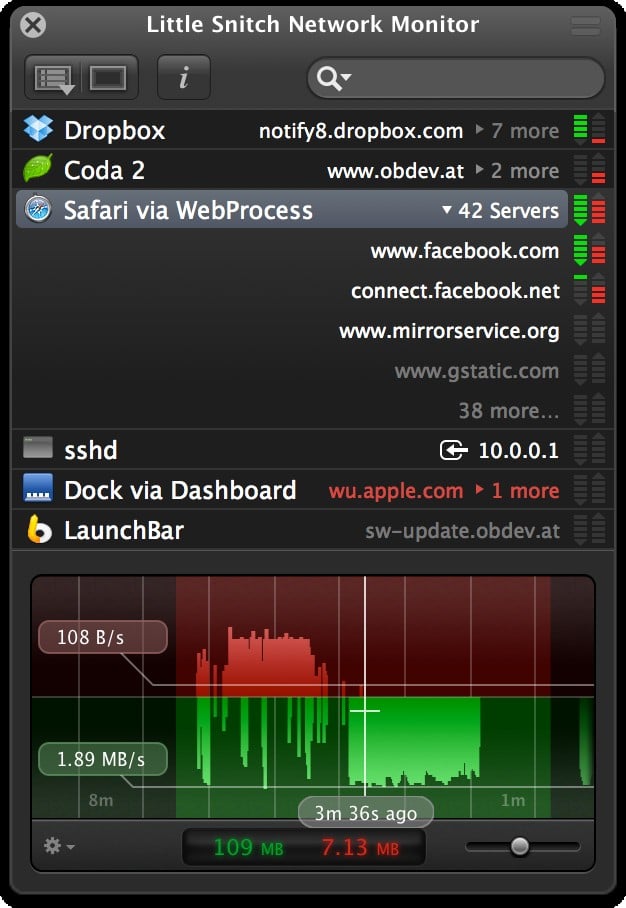
- Little snitch for mac yosemite update#
- Little snitch for mac yosemite software#
- Little snitch for mac yosemite simulator#
- Little snitch for mac yosemite windows#
List other hostnames resolving to same IP address. pcap file to open it with packet analyzer tools (such as Wireshark or Cocoa Packet Analyzer). Capture traffic of certain applications as. Save snapshots to investigate connection details at any later point of time. Powerful sorting options (last activity, total traffic amount, process name, server name, …). Selecting in the traffic view causes connection list to only show applications that where active (caused traffic) during that time. Supports multi-touch gestures for scrolling and zooming. Display data rates on logarithmic or linear scale. Highlighting of system events (application launched, application terminated, computer sleep, …). Visual representation of traffic amounts over time. Fixed a bug which caused a kernel panic in some rare cases. Updated help section to reflect changes mentioned above.  Improved “Restore Factory Defaults” feature. In the menu bar item “Silent Mode” and “Start/Stop Network Filter” entries are now hidden if “Allow Preferences Editing” is disabled. To use it, it must be enabled in Little Snitch Configuration > Preferences > Automatic Profile Switching. The mappings between profiles and networks can be reviewed and edited later in Little Snitch Configuration, either in the profiles section of the sidebar, or in the new “Known Networks” window (⇧⌘K).Īutomatic Profile Switching is off by default. Alternatively you can configure a default profile that will be used for all unknown networks. When you join a network for the first time, Little Snitch shows an alert window allowing you to choose the desired profile. Whenever you join one of these networks, Little Snitch detects the network change and switches This new feature allows you to assign networks (for example your Wi-Fi network at home, a public hotspot, etc.) to certain profiles. Fixed an OS X 10.6 related drawing bug in Little Snitch Configuration sidebar. Fixed an issue where Little Snitch Agent appeared to have crashed. Fixed an issue causing Little Snitch Network Monitor to disappear when dragged on another screen on OS X 10.9. Fixed issues causing Little Snitch Network Monitor not to appear in multiple screen environments.
Improved “Restore Factory Defaults” feature. In the menu bar item “Silent Mode” and “Start/Stop Network Filter” entries are now hidden if “Allow Preferences Editing” is disabled. To use it, it must be enabled in Little Snitch Configuration > Preferences > Automatic Profile Switching. The mappings between profiles and networks can be reviewed and edited later in Little Snitch Configuration, either in the profiles section of the sidebar, or in the new “Known Networks” window (⇧⌘K).Īutomatic Profile Switching is off by default. Alternatively you can configure a default profile that will be used for all unknown networks. When you join a network for the first time, Little Snitch shows an alert window allowing you to choose the desired profile. Whenever you join one of these networks, Little Snitch detects the network change and switches This new feature allows you to assign networks (for example your Wi-Fi network at home, a public hotspot, etc.) to certain profiles. Fixed an OS X 10.6 related drawing bug in Little Snitch Configuration sidebar. Fixed an issue where Little Snitch Agent appeared to have crashed. Fixed an issue causing Little Snitch Network Monitor to disappear when dragged on another screen on OS X 10.9. Fixed issues causing Little Snitch Network Monitor not to appear in multiple screen environments. Little snitch for mac yosemite update#
Installer detects Little Snitch Configuration in locations other than /Application and performs update accordingly.Host- and domain rules now have priority over local network rules.Improved window positioning of Little Snitch Monitor.Improved handling of certain VPN connections.
Little snitch for mac yosemite windows#
Little Snitch Network Monitor respects “Reopen windows when logging back in” option now.Little Snitch Network Monitor Inspector performance improvements.Improved Little Snitch Configuration sidebar: Added explanatory texts.Improved dealing with large amount of silent mode suggestions.

We will gradually enable HTTPS for all other connections to our servers in the near future.
Little snitch for mac yosemite software#
Software update checks are now using HTTPS. Snapshots now store the user’s names and show them correctly. Fixed: The process owner in Network Monitor Snapshots was “root” instead of the actual user in many cases. 
Little Snitch menu bar item no longer occupies space when disabled.To ensure incoming SSH connections work as expected. On OS X Yosemite, this version of Little Snitch automatically converts existing rules Incoming connections are no longer handled by sshd directly but instead by launchd. OS X Yosemite changed how incoming ssh connections are handled.Until Quit rules are now valid until both the parent process and via process have terminated.Connection alerts now show a cancel button if either the parent or the via process is terminated.Added support for showing iOS App Extension icons.
Little snitch for mac yosemite simulator#
Read our blog post for details on how iOS Simulator
Greatly improved support for iOS Simulator apps in Connection Alerts, Network Monitor and Configuration.







 0 kommentar(er)
0 kommentar(er)
